BHUTAN
Religion

Religion

Religion
General
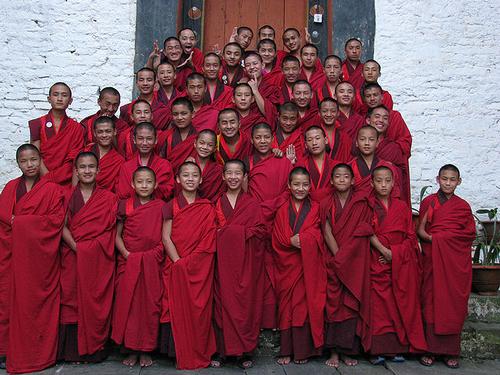 Bhutanese student monksPhoto: Muddum27 CC 2.0 Generic no changes made
Bhutanese student monksPhoto: Muddum27 CC 2.0 Generic no changes made
About 75% of the population adheres to the Buddhist faith. The other 25% of the population is Hindu. Buddhism is practiced all over the country, but in the south, most of the people of Nepalese or Indian descent are Hindus. Buddhists and Hindus get along well in Bhutan, because Hindu festivals also provide a day off for the entire population. Small minorities adhere to other religions, including an animist religion such as Bon, the predecessor of Himalayan Buddhism. There is also a small number of Christians. Bhutan is tolerant of all religions, but conversion activities are prohibited in Bhutan.
Buddhism originated in the 5th / 6th century BC in northern Central India according to the teachings of Siddharta Gautama, better known as Sakyamuni Buddha. Little is known about this important figure, but legend has it that his parents lived in Sakya, a small kingdom on the border of present-day Nepal and India. Shortly after his birth, a wandering ascetic predicted that the young prince would become a world-conquering king or a liberator from suffering living beings. After fleeing his parents' palace, Siddahrta also became an itinerant ascetic, doing nothing but fasting and meditating. In Bodhgaya (Bihar, India), Siddharta began to meditate under a tree, promising to meditate until he reached a state of enlightenment. On the third day of his meditations, he attained Buddha status. Buddhism has no gods and no worship services, it really only provides guidelines for a meaningful life.
Buddhism is the most malleable and constantly adapting religion in the world. Buddhism adapts to local conditions without much difficulty and as a result, new schools arose over the centuries, two of which have become the most important. The main difference between the various schools is the ultimate goal that the Buddhist sets for the spiritual path he or she takes.
THERAVADA (also called Hinayana): This form of Buddhism is mainly found in Sri Lanka, Thailand and Myanmar (Burma) and Cambodia. In the Theravada tradition, the individual tries to attain a liberated status, the Nirvana, through suffering (samsara). One who attains this status is called an Arhat. The Theravada tradition is based on writings recorded in Pali.
MAHAYANA: in the first century AD. originated in India and now mainly practiced in China, Japan, Tibet, Vietnam and South Korea. In Mahayana one pursues a higher goal than in the Theravada tradition. Love and compassion are even more important in Mahayana than in Theravada, and the ultimate goal is to free all sentient beings from cyclical existence. To redeem others one must first have attained the Buddha status as Bodhisattva oneself. The Mahayana tradition was originally recorded in Sanskrit.
VAJRAYANA (also called Tantrism or Tantric Buddhism): in this movement one wants to attain Buddhahood and from there lead other sentient beings to enlightenment, especially through rituals and initiations. Originated in India around 600 from Mahayana and is mainly practiced in the Tibetan Buddhism of Tibet, Nepal and Mongolia. In Bhutan, Vajrayana is the 'state religion', with the main schools being Nyingmapa in Central and Eastern Bhutan and Drukpa School in Western Bhutan. Vajrayana is also gaining in popularity in the western spiritual world, and Japanese Shingon, a major movement in Japanese Buddhism, is also a Vajrayana school.
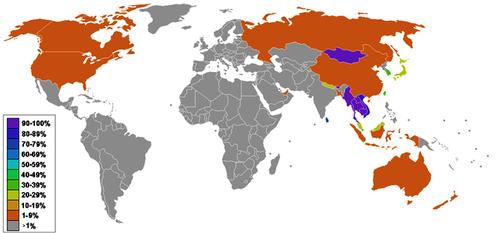
Spread of Buddhism around the worldPhoto: Public domain
Inseparable from Buddhism, and therefore also in Bhutan, are the many cylindrical prayer wheels, in all sizes and types, often made of wood, metal or leather. On the outside of the mill is a prayer or mantra, and spinning the prayer wheel has the same effect for Buddhists as saying the prayer or mantra in question. The most used mantra and also the most recited mantra in Tibetan Buddhism is 'om mani padme hum'. Most Tibetologists, after centuries of discussion, believe that the mantra is an invocation of "(The possessor of) the Jewel-Lotus" the Bodhisattva Avalokitesvara.
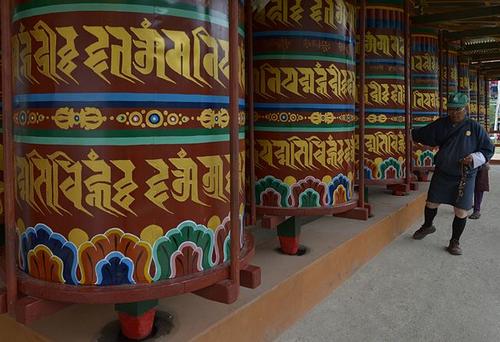 Prayer wheels BhutanPhoto: Christopher J. Fynn CC 3.0 Unported no changes made
Prayer wheels BhutanPhoto: Christopher J. Fynn CC 3.0 Unported no changes made
Special religious buildings
A 'dzong' is a fortified monastery where monks often live and government officials work.
CHOKHOR VALLEY
Jampey Lhakhang: temple, probably built in 659 by the Tibetan king Songtsen Gampo. The central figure in the inner sanctuary of the temple is Jampa, the Buddha of the Future, with his foot on an elephant. This chapel is the oldest chapel in Bhutan. The inner processional hall has murals depicting 1000 Buddhas. On the walls of the Kalachakra temple are deities with animal heads, demons who resist death the 49-day 'bardo' period, the period between death and rebirth. in October every year one of Bhutan's spectacular festivals takes place here, the Jampey Lkakhang Drup.
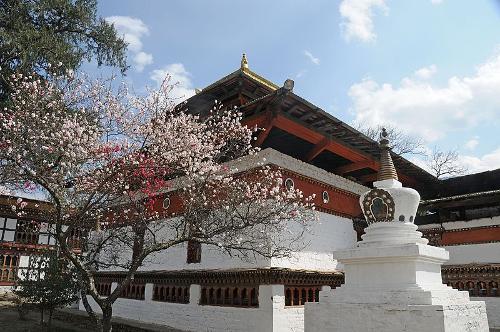 Kyichu Lhakhang, BhutanPhoto: David Broad CC 3.0 Unported no changes made
Kyichu Lhakhang, BhutanPhoto: David Broad CC 3.0 Unported no changes made
LANGO
Kyichu Llakhang: one of Bhutan's oldest and most beautiful temples. The temple's construction is generally attributed to the Tibetan King Songtsen Gampo in 659. Inside, one of the greatest treasures can be found, a 7th century statue of Jowo Sakyamuni, one of the most revered and sacred objects in Tibetan. Buddhism because it is said to be the first statue of the historic Buddha at the age of 12. The main statue of the Jowo Shakyamuni is in Lhasa, the capital of Tibet.
PARO
Paro Dzong (full name: Rinchen Pung Dzong): This 17th century dzong is one of the most impressive and well-known dzongs in Bhutan, and perhaps the finest example of Bhutanese architecture to be found in the country. Survived the 1897 earthquake but was badly damaged by fire in 1907. About 200 monks live in this dzong and in the past the National Assembly met here.
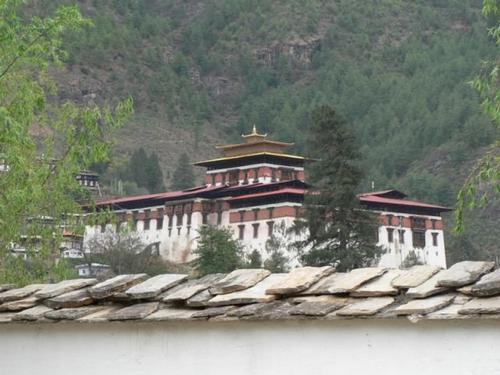 Paro Dzong, a fine example of Bhutanese architecturePhoto: Stephen Shepard CC 3.0 Unported no changes made
Paro Dzong, a fine example of Bhutanese architecturePhoto: Stephen Shepard CC 3.0 Unported no changes made
THIMPHU
Trashi Chhoe Dzong: also in this 'dzong' monks live and work government officials, in this case from Internal Affairs and Finance. In this dzong, the fifth king of Bhutan, Jigme Khesar Namgye (1980-), was crowned in 2008. In the early 1960s, the dzong was renovated and expanded in the traditional Bhutanese way, that is, without nails and without construction drawings.
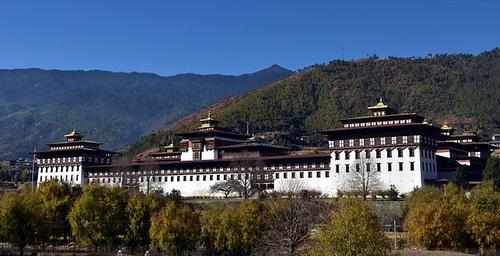 Trashi Chhoe Dzong, Thimpthu, BhutanPhoto: Christopher J. Fynn CC 3.0 Unported no changes made
Trashi Chhoe Dzong, Thimpthu, BhutanPhoto: Christopher J. Fynn CC 3.0 Unported no changes made
Thimphu Chorten: Tibetan style Buddhist stupa built in 1974 in honor of the third king or 'Druk Gyalpo' of Bhutan, Jigme Dorji Wangchuck (19128-1972). No royal remains or relics are kept in the stupa, only a picture of the king in ceremonial robes.
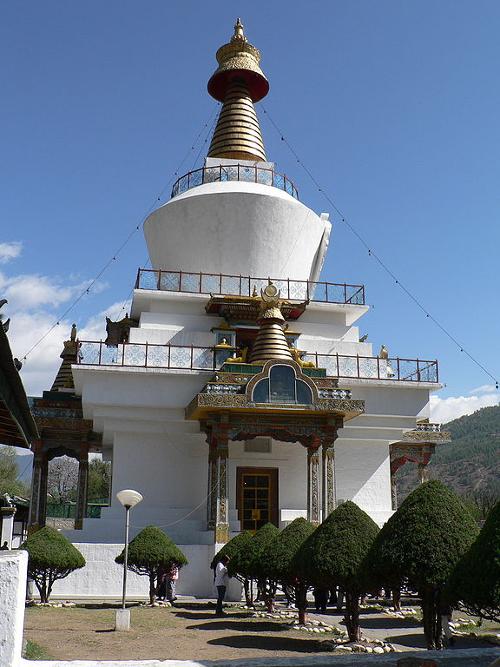 Thimphu Chorten, BhutanPhoto: Stephen Shephard CC 3.0 Unported no changes made
Thimphu Chorten, BhutanPhoto: Stephen Shephard CC 3.0 Unported no changes made
Dordenma Buddha: 42 meter high bronze Shakyamuni Buddha statue made in China at the beginning of the Thimpthu Valley. The three-storey 20-meter-high throne contains several chapels and the statue itself is filled with 100,000 approximately 20 cm large Buddha statues. Another 25,000 Buddha statues of approximately 30 cm are placed in the throne.
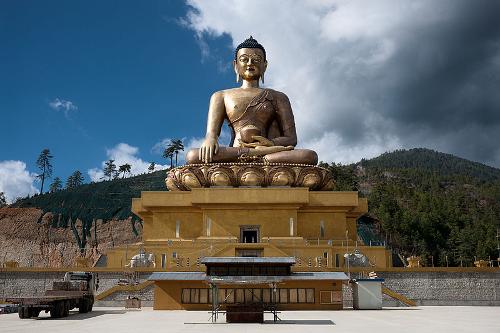 Shakyamuni-buddha, BhutanPhoto: Vertalm CC 4.0 International no changes made
Shakyamuni-buddha, BhutanPhoto: Vertalm CC 4.0 International no changes made
Changangkha Lhakhang: Fort-like Buddhist temple on a rocky outcrop above the center of Thimphu. Built in the 12th century on a site chosen by lama Phajo Drukgom Shigpo.
PARO VALLEY
Taktshang Goemba: Bhutan's most famous monastery, located on a rocky outcrop 900 above the bottom of the valley. The monastery is a 'ney', a holy place, and pilgrims from all over Bhutan come to this place. Seriously damaged by fire in 1998, reconstruction started in 2000 and in 2005 the complex was consecrated again in the presence of the king.
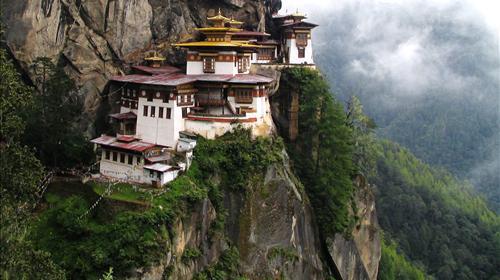 Taktshamg Goemba, BhutanPhoto: Douglas J. McLaughlin CC 3.0 Unported no changes made
Taktshamg Goemba, BhutanPhoto: Douglas J. McLaughlin CC 3.0 Unported no changes made
PUNAKHA
Punakha Dzong: Located in Punakha, the former capital of Bhutan, this dzong is considered the most beautiful in Bhutan. The Punakha Dzong is 180 meters long, 72 meters wide and the central tower, the 'utse', has six floors. The dzong has faced earthquakes, fires and floods over time. What is special is that the dzong has three courtyards instead of the usual two. Bhutan's most precious possession, an image of Chenresig, is kept in the central tower of the dzong and only brought out during the 'domchoe' festival. The chenresig is the "bodhisattva", (a being who has the ability to become buddha during his lifetime, but refuses to help reincarnate other beings, who is most appreciated among Buddhists.
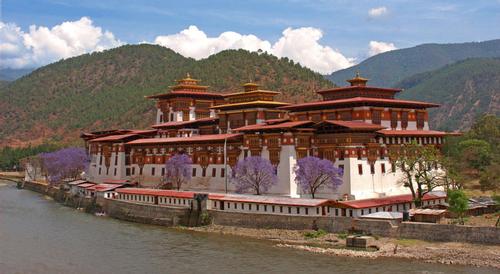 Punakha Dzong, BhutanPhoto: Jean-Marie Hullot CC 3.0 Unported no changes made
Punakha Dzong, BhutanPhoto: Jean-Marie Hullot CC 3.0 Unported no changes made
TRONGSA
Trongsa Dzong: spectacularly located dzong, official name Chhoekhor Raptentse Dzong, whose history dates back to the 16th century. As the dzong looks today, it was built in 1644 by Chhogyel Mingyur Tenpa and expanded at the end of the 17th century. Badly damaged by the earthquake of 1897. The excellent strategic position of the Trongsa Dzong gave a lot of power over this part of Bhutan, being right on the trade route from east to west, which resulted in a lot of tax money. The dzong contains 23 temples with decorations that mainly date from the time when the first king, Ugyen Wangchuck, ruled Bhutan.
Sources
BBC - Country Profiles
Brown, Lindsay / Bhutan
Lonely Planet
CIA - World Factbook
Dorje, Gyurme / Bhutan Handbook
Footprint
Elmar Landeninformatie
Jordans, Bart / Bhutan : a trekker's guide
Cicerone
Pommaret, Françoise / Bhutan : Himalayan mountain kingdom
Odyssey
Te gast in Bhutan
Informatie Verre Reizen
Copyright: Team The World of Info